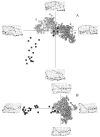Evolution of skull and mandible shape in cats (Carnivora: Felidae)
- PMID: 18665225
- PMCID: PMC2475670
- DOI: 10.1371/journal.pone.0002807
Evolution of skull and mandible shape in cats (Carnivora: Felidae)
Abstract
The felid family consists of two major subgroups, the sabretoothed and the feline cats, to which all extant species belong, and are the most anatomically derived of all carnivores for predation on large prey with a precision killing bite. There has been much controversy and uncertainty about why the skulls and mandibles of sabretoothed and feline cats evolved to become so anatomically divergent, but previous models have focused on single characters and no unifying hypothesis of evolutionary shape changes has been formulated. Here I show that the shape of the skull and mandible in derived sabrecats occupy entirely different positions within overall morphospace from feline cats, and that the evolution of skull and mandible shape has followed very different paths in the two subgroups. When normalised for body-size differences, evolution of bite forces differ markedly in the two groups, and are much lower in derived sabrecats, and they show a significant relationship with size and cranial shape, whereas no such relationship is present in feline cats. Evolution of skull and mandible shape in modern cats has been governed by the need for uniform powerful biting irrespective of body size, whereas in sabrecats, shape evolution was governed by selective pressures for efficient predation with hypertrophied upper canines at high gape angles, and bite forces were secondary and became progressively weaker during sabrecat evolution. The current study emphasises combinations of new techniques for morphological shape analysis and biomechanical studies to formulate evolutionary hypotheses for difficult groups.
Conflict of interest statement
Figures



References
-
- Martin LD. Functional morphology and the evolution of cats. Trans Nebraska Acad Sci. 1980;8:141–154.
-
- Turner A, Antón M. The big cats and their fossil relatives. An illustrated guide to their evolution and natural history. New York: Columbia University Press; 1997. p. 234.
-
- Leyhausen P. Cat behavior. New York: Garland STPM Press; 1979. p. 340.
-
- Biknevicius AR, Van Valkenburgh B. Design for killing: Craniodental adaptations of predators. In: Gittleman JL, editor. Carnivore behavior, ecology, and evolution, vol. II. New York: Cornell University Press; 1996. pp. 393–428.
-
- Christiansen P, Wroe SM. Bite forces and evolutionary adaptations to feeding ecology in carnivores. Ecology. 2007;88:347–358. - PubMed
Publication types
MeSH terms
LinkOut - more resources
Full Text Sources
Miscellaneous

